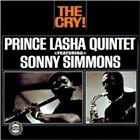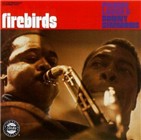Home » Jazz Articles » Profile » Prince Lasha
Prince Lasha
It seemed like the sound was coming up out of the ground, up through the bottom of the horn and out through the bell. That's one of the most mysterious, magical and frightening things?about the Texas sound.
 Lasha is a year older than Ornette Coleman, and being brought up in Fort Worth, he had contact with Ornette at a very young age. "He wanted [a saxophone] at the same time I did, 'cause we were in school together, and we both got a job being a waiter at the Texas Hotel for Sneed's. We were early teenagers and just getting into high school." Ornette and Lasha were in orchestra and band together, "We got kicked out a couple of times but they always called us back, you know" and they were a nightclub team as well, working blues bands and making a good living as teenagers in North Texas. Working with Ornette, Harold Land and in the band of Jimmy Liggett, internalizing the Texas saxophone tradition that has been carried on in Ornette, Booker Ervin, Illinois Jacquet and many others, brought Lasha to a conception of the horn that differs substantially from the East Coast "ornithologists", though they are branches of the same tree.
Lasha is a year older than Ornette Coleman, and being brought up in Fort Worth, he had contact with Ornette at a very young age. "He wanted [a saxophone] at the same time I did, 'cause we were in school together, and we both got a job being a waiter at the Texas Hotel for Sneed's. We were early teenagers and just getting into high school." Ornette and Lasha were in orchestra and band together, "We got kicked out a couple of times but they always called us back, you know" and they were a nightclub team as well, working blues bands and making a good living as teenagers in North Texas. Working with Ornette, Harold Land and in the band of Jimmy Liggett, internalizing the Texas saxophone tradition that has been carried on in Ornette, Booker Ervin, Illinois Jacquet and many others, brought Lasha to a conception of the horn that differs substantially from the East Coast "ornithologists", though they are branches of the same tree."I did the experiment of standing next to Sonny Rollins, John Coltrane and Eric Dolphy, standing next to them. It seemed like the sound was coming up out of the ground, up through the bottom of the horn and out through the bell. That's one of the most mysterious, magical and frightening things'about the Texas sound."
After a brief foray with New York in the middle '50s, where Lasha lived in the same building as members of the Ellington band and Sonny Rollins and his mother, Lasha returned to Texas briefly and, after hearing that California showed promise for a young jazzman (Ornette had just recorded his album Something Else!!! ), he jumped ship for the West Coast in 1958. Lasha wound up in Oakland and soon met Sonny Simmons, then going under the name Huey Simmons. After woodshedding in Oakland, Lasha and Simmons decided to make a go of it once again in New York: "I was in the music store one day and heard this alto player and Simmons and I looked up and I said 'who is that' and he said 'That's Eric Dolphy.' I said 'Eric who? Is that Eric Dolphy in New York?' because I knew Ornette Coleman, my school band mate, was supposed to be the greatest in the world, and I said 'look, Simmons, you gonna be ready to go in a couple weeks?'" New York appeared to be waiting for Lasha and Simmons, because when Lasha called Dolphy from the road, he heard their record The Cry! playing in the background on the phone.
Dolphy's loft was a hub of activity and Lasha and Simmons played with Charles Moffett (a school chum of Ornette and Lasha), Clifford Jordan, Bobby Hutcherson and Anthony Williams, eventually leading to the Douglas and FM sessions that produced Iron Man and Conversations. Lasha was also prominently featured on Elvin Jones' session Illumination! (Impulse!, 1963), which joined the Coltrane rhythm section with a front line of Lasha, Simmons and baritone saxophonist Charles Davis. Lasha's unique, Eastern-flavored composition "Nuttin' Out Jones" ("nutting out"="flaking out") was the album opener, featuring the woody multiphonics of Lasha's clarinet in dialogue with Jones. Lasha originally wanted to use the Coltrane rhythm section for his own date, but as Coltrane was very particular about his band, it turned out that Lasha and Simmons made Jones' date instead - yet they still made it very much their own session.
 Lasha was in Kensington, England through 1966 and subsequently returned to California, where he assembled a group with Moffett, Bobby Hutcherson and Buster Williams, recording Firebirds (Contemporary, 1967) and playing the Monterey and Berkeley jazz festivals, portions of which were released on Lasha's own label, Birdseye. Lasha has taken his music underground somewhat since the late '70s, while he translated his musical self-reliance into becoming successful in real estate. Yet throughout he has been composing and studying, encouraging his sons musically (one is a flutist and two are drummers - one another Prince Lasha) and practicing the insight and uniqueness that helped him change the landscape of improvised music in California, New York and even the UK - an improviser for whom "nutting out" is far from reality.
Lasha was in Kensington, England through 1966 and subsequently returned to California, where he assembled a group with Moffett, Bobby Hutcherson and Buster Williams, recording Firebirds (Contemporary, 1967) and playing the Monterey and Berkeley jazz festivals, portions of which were released on Lasha's own label, Birdseye. Lasha has taken his music underground somewhat since the late '70s, while he translated his musical self-reliance into becoming successful in real estate. Yet throughout he has been composing and studying, encouraging his sons musically (one is a flutist and two are drummers - one another Prince Lasha) and practicing the insight and uniqueness that helped him change the landscape of improvised music in California, New York and even the UK - an improviser for whom "nutting out" is far from reality.Recommended Listening:
Prince Lasha, The Cry! (Contemporary-OJC, 1962)
Eric Dolphy, Iron Man (Douglas-Affinity, 1963)
Prince Lasha, Inside Story (Enja-Inner City, 1965)
Prince Lasha/Sonny Simmons, Firebirds (Contemporary-OJC, 1967)
Elvin Jones/Jimmy Garrison Sextet, Illumination (featuring McCoy Tyner) (Impulse!, 1963)
Prince Lasha, Firebirds Live, Vol.1-3 (Birds Eye, 1974)
Tags
PREVIOUS / NEXT
Support All About Jazz
 All About Jazz has been a pillar of jazz since 1995, championing it as an art form and, more importantly, supporting the musicians who make it. Our enduring commitment has made "AAJ" one of the most culturally important websites of its kind, read by hundreds of thousands of fans, musicians and industry figures every month.
All About Jazz has been a pillar of jazz since 1995, championing it as an art form and, more importantly, supporting the musicians who make it. Our enduring commitment has made "AAJ" one of the most culturally important websites of its kind, read by hundreds of thousands of fans, musicians and industry figures every month.






















